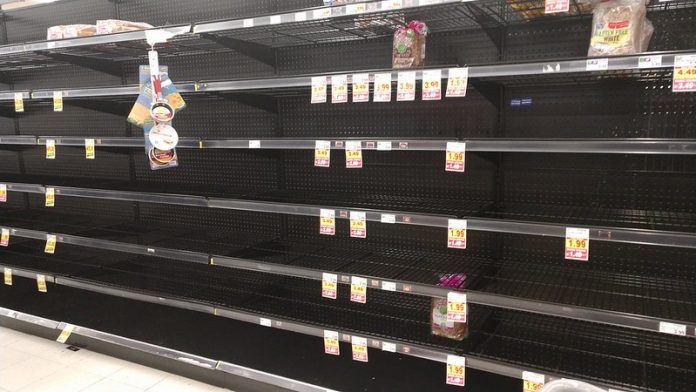It’s not hard to see the writing on the wall when supply chains are interrupted, diesel fuel prices rise, and wheat-producing countries feel the sting of lost grain crops due to war, violence, heat, and export restrictions.
Countries that get most of their grains from Russia and Ukraine may be the first to feel the effects of food insecurity caused by shortages.
There is some good news, though: the US ranks fourth globally in terms of wheat production, following only China, Russia, and India.
Therefore, I guess we shouldn’t worry too much. Actually, not quite. The majority of the wheat is sent to other countries around the world, making it a major player in the global market.
Even though North Americans probably won’t go hungry because of this shortage, prices are likely to go up a lot, and the number of baked goods and other foods that use wheat is likely to go down.
But since bread and wheat are so essential to humans, this would send people into a panic. Not only wheat is at risk in this situation. There are also shortages and record-high prices for several other grains and oil commodities, including rye, sunflower, rapeseed, and more.
Since everyone witnessed what happened during the Great Toilet Paper Panic of 2020, among other strange events, one thing is very clear: when faced with shortages, individuals have a tendency to act irrationally.
We should all try to personally prepare ourselves as much as we can before it’s too late because of this. Here are just a few things you can do to get ready for the impending shortage of wheat and grains.
Whole Wheat Flour
Compared to its bleached-white equivalent, whole wheat flour has more important vitamins and minerals.
Even though whole wheat includes significant quantities of calcium, vitamin D, iron, fiber, and other nutrients, it tends to have a shorter shelf life and is more challenging to store for an extended period of time.
Whole wheat flour goes bad faster than white flour, which makes up for the fact that it has more nutrients. Repackaged wheat flour can be kept for up to a year in ideal conditions if kept in a cool, dark, and dry area.
So, if you decide to stock up on whole wheat flour, you should take steps to keep it from going bad or use it sooner than your other flour for the best results.
Whole wheat flour has an average moisture content of 14–15%, so it is best to store it in a mylar bag or an airtight food-safe container with oxygen absorbers.
All-Purpose Flour
The most flexible and often used kind of flour is all-purpose flour, also referred to as refined or bleached white flour. Because of this, it might be easier to find than others if there are shortages or prices go up.
During the refining process, however, the bran and germ of the wheat kernel are taken out. This means that many essential vitamins and minerals are also lost.
This procedure has been used in the past to appease customers who favor the color white.
In its natural condition, bleached flour has a more creamy off-white hue. The good news is that this sort of flour keeps quite well, despite the fact that the nutrient profile of bleached flour isn’t as outstanding as that of wholewheat flour.
Related: 11 Survival Tricks You Can Learn from Homeless People
Under ideal circumstances, all-purpose flour can be stored for up to 5–10 years. It’s crucial to remember that flour’s original packaging isn’t made to withstand long-term storage.
This means that if you don’t repackage your flour, it may pick up dust, bug eggs, moisture, or other impurities over time. So, if you want to keep flour for later use, you should move it from the bag it came in into a container.
For optimal results, keep your flour in an airtight bag or container and keep it out of the sun and humidity in a cold, dry location.
Unbleached Flour
All-purpose flour and bleached flour are refined flours that have been aged with chemicals. Unbleached flour has aged naturally over time.
Unbleached flour is nevertheless technically “bleached” by nature. Unbleached flour isn’t as dazzling and pure white as bleached flour, though.
In order to maintain the nutrient profile, unbleached flour might not be able to hold as many nutrients as you might think. Due to the natural aging and bleaching processes, many important nutrients are still being lost. In actuality, bleached flour has a minor nutritional advantage over unbleached flour.
Since unbleached flour hasn’t had a chemical wash and has a more natural texture and flavor, many people prefer it.
If you want to keep a lot of extra nutrients, though, you should look for “enriched” bleached and unbleached flours. The method of enriching flour involves reintroducing the nutrients that have been removed to the finished good.
Related: How To Get Survival Products When You Have Almost No Money
Traditional unbleached flour and enhanced flour have the same shelf life as white flour. Still, you can make it last longer by storing it in the right way, just like you would with all-purpose flour.
Alternative Flours
Seeds, oil grains, nuts, and other plant materials are used to make a lot of alternative flours. You can bake with these flours or mix them with other flours to make a more nutritious mixture.
These flours do, however, tend to have a shorter shelf life due to their increased fat content.
For instance, it takes between three and six months for almond and coconut flour to start to go bad. The same is true for flours made from nuts, roots, or plants.
Therefore, it’s crucial to use certain kinds of flour before other, harder grains when storing them. You might be able to make your products last longer if you store them properly and keep them out of the sun, heat, and moisture.
Buying Wheat Berries In Bulk
Wheat berries are a wonderful choice for grain storage due to their long shelf life and lower price per pound when compared to other grains.
Wheat berries are the remaining hulled grain kernels that are still edible.
The germ and endosperm make up the rest of the kernel, which is called the “bran.” Wheat berries come in a variety of varieties.
However, most people opt for hard red wheat, soft white wheat, or a blend of the two due to their hardness and consistency in bread manufacturing.
Although you can soak and cook these grains to make meals, many people choose to use an electric or hand mill to grind their berries into flour. By doing this, you may make 2 cups of flour from roughly 1 cup of grains.
Buying whole wheat berries for your stockpile is a smart way to keep grains for a very long time. Wheat berries can live up to 30 years if properly stored.
How To Store Flour And Grains
Your grain supply can be destroyed by bugs and water, so it’s important to store your grains and flour carefully. There are a few tried-and-true methods for keeping flour fresh for a long time.
Of course, freezing it is a possibility as well. But in far too many SHTF scenarios, relying on electricity to freeze food might not be the best option.
In light of this, dry canning flour is the ideal method of long-term storage. This will stop any moisture from affecting the flour’s quality.
If you can’t dry-can flour, you can keep it fresh for years after its normal shelf life by putting it in a food-grade container that is airtight, lined with a mylar bag, and has enough oxygen absorbers.
Canning is not really required when keeping wheat berries and other whole grains. The best place to store grains is in a 5-gallon food-grade bucket or another comparable container because of the density of wheat kernels and their low moisture content. When you need your grains the most, keep them in a cold, dry, and dark location to keep them safe to eat.
Even though it seems like this coming grain shortage will soon have a big effect on the world, it is always important to stay calm and realistic.
It’s comforting to know that, even if the grain shortage doesn’t directly affect you as you had hoped, you can still improve your readiness for whatever challenges life may present.




